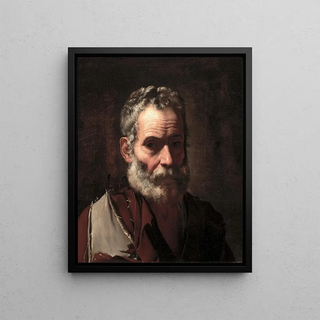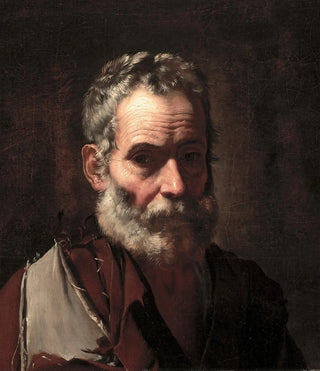Art print | An Old Man - Jusepe de Ribera


View from behind

Frame (optional)
In the fascinating world of baroque painting, "Un vieil homme" by Jusepe de Ribera stands out for its emotional depth and technical mastery. This artwork, imbued with the characteristic light and shadow of the artist, invites us to delve into the soul of a character marked by time. The expression of the old man, both melancholic and wise, evokes a personal story that each viewer can embrace. The art print of this iconic piece allows for appreciation of the richness of details and the subtlety of colors, while offering a glimpse into human life and concerns through the lens of art.
Style and uniqueness of the work
Ribera's style is characterized by striking realism, an approach fully expressed in "Un vieil homme." The play of light accentuates facial features, revealing wrinkles and imperfections that tell a story of a life full of experiences. The color palette, dominated by warm and earthy tones, creates an atmosphere that is both intimate and dramatic. This painting stands out for its ability to capture the very essence of the human condition, oscillating between the fragility of existence and the dignity of the elderly. Ribera, a true master, manages to transcend mere representation to offer a reflection on aging and wisdom, inviting the viewer to contemplate their own mortality.
The artist and his influence
Jusepe de Ribera, born in Spain and having spent much of his life in Italy, is often regarded as one of the greatest representatives of Spanish baroque. His work is not limited to simple pictorial technique but extends to a profound exploration of the human condition. Influenced by Caravaggio, Ribera adopts chiaroscuro to heighten the drama of his compositions. His ability to depict often overlooked subjects, such as beggars or the elderly, gives him a unique place in art history. "Un vieil homme" perfectly illustrates this sensitivity, demonstrating the lasting impact Ribera had on his contemporaries and on the generations of artists who followed. His realistic approach and emotio

Matte finish

View from behind

Frame (optional)
In the fascinating world of baroque painting, "Un vieil homme" by Jusepe de Ribera stands out for its emotional depth and technical mastery. This artwork, imbued with the characteristic light and shadow of the artist, invites us to delve into the soul of a character marked by time. The expression of the old man, both melancholic and wise, evokes a personal story that each viewer can embrace. The art print of this iconic piece allows for appreciation of the richness of details and the subtlety of colors, while offering a glimpse into human life and concerns through the lens of art.
Style and uniqueness of the work
Ribera's style is characterized by striking realism, an approach fully expressed in "Un vieil homme." The play of light accentuates facial features, revealing wrinkles and imperfections that tell a story of a life full of experiences. The color palette, dominated by warm and earthy tones, creates an atmosphere that is both intimate and dramatic. This painting stands out for its ability to capture the very essence of the human condition, oscillating between the fragility of existence and the dignity of the elderly. Ribera, a true master, manages to transcend mere representation to offer a reflection on aging and wisdom, inviting the viewer to contemplate their own mortality.
The artist and his influence
Jusepe de Ribera, born in Spain and having spent much of his life in Italy, is often regarded as one of the greatest representatives of Spanish baroque. His work is not limited to simple pictorial technique but extends to a profound exploration of the human condition. Influenced by Caravaggio, Ribera adopts chiaroscuro to heighten the drama of his compositions. His ability to depict often overlooked subjects, such as beggars or the elderly, gives him a unique place in art history. "Un vieil homme" perfectly illustrates this sensitivity, demonstrating the lasting impact Ribera had on his contemporaries and on the generations of artists who followed. His realistic approach and emotio






